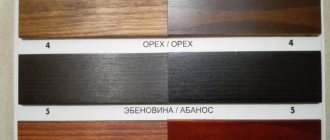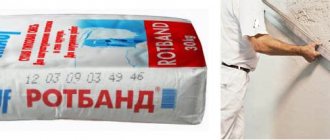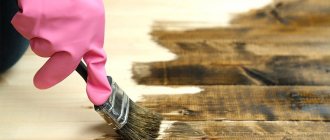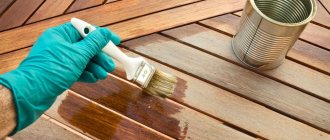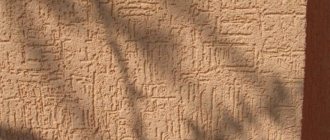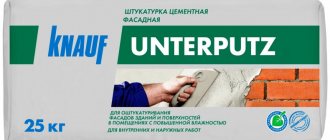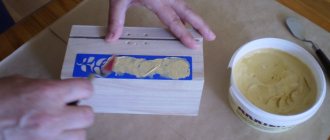Only oil can preserve and highlight the pristine beauty of wood.
What can it be applied to?
Oil-based preservatives can be used to protect common and exotic (mostly hardwood) wood indoors and outdoors.
In rooms, they are most often chosen to protect wooden floors and stairs.
- Manufacturers offer special mixtures called parquet oils, wood floor oils or stair oils.
- Special wood oils can also be successfully used to care for wooden countertops in kitchens or bathrooms (countertop oils), as well as to protect wooden furniture (furniture oils).
However, as mentioned above, before purchasing, you should ask about how toxic these oils are. It is better not to risk your health and choose the least harmful option.
Let's sum it up
Concluding the review of oils for internal impregnation, we separately note the fact that the apparent simplicity of the technology is deceptive, and the quality of the resulting coating directly depends on knowledge of all the nuances of using protective compounds.
We are the official dealer of the most popular brands of impregnating oils, therefore our specialists are constantly trained at qualification seminars and courses conducted by manufacturers, which guarantees compliance with all standards and requirements when performing work.
accepts orders for finishing, repair and restoration of log houses for log and timber houses. Facilities in Moscow and the Moscow region are serviced. You can clarify the specifics of cooperation and order a visit from a specialist to assess the scope of work by phone, through the feedback form or by e-mail, which are posted in the “Contacts” section.
Calculate the cost of painting and insulating your home right now
Select types of work:
Select materials:
How does wood oil work?
Wood oil applied to its surface penetrates to a certain depth into the structure of this material. In most cases, organic solvent-based oil shows better permeability than water-based oil, which is important. Organic oil particles envelop all wood elements.
Since they themselves are water-repellent, they prevent moisture from coming into contact with the wood and also promote evaporation.
Improved compositions
Since each of the listed types of oils, along with its advantages, usually also has a number of disadvantages, a wide window of opportunity has opened for manufacturers of construction chemicals in the development of improved oil impregnation compositions.
Modern oil protective compounds are only based on a natural base, and the necessary technical properties are achieved by adding the following types of additives:
- other oils with highly targeted properties;
- substances that accelerate polymerization (driers);
- additives that increase resistance to ultraviolet rays;
- tinting components;
- bactericidal additives;
- natural or artificial wax.
The most famous brands among oil impregnations today are Osmo, Teknos, Gnature, Tikkurila, Aquatex and Biofa. Our company is the official dealer of these products, therefore, when ordering work using the listed types of oils, it is possible to pay their cost at a wholesale price.
Wood oil base
Wood oils can be based on organic solvents or water.
- Oils based on organic solvents penetrate the wood structure much better, providing longer-lasting protection. However, the solvents themselves are very toxic, volatile and flammable, so their use is currently limited, although they are more effective.
- Water-based oils do not penetrate wood well, so they are used to lubricate the hardest types of wood and elements that will not be subjected to too intense use. The advantage of water-based oils is that they are (relatively) non-toxic and that they do not leave a distinctive odor.
Rating of premium wood oils
Osmo Anti-Rutsch Terrassen-Öl with anti-slip effect
The first place in our rating is occupied by a quality product from the famous German concern Osmo. An excellent option under 5,000 rubles, which will give the surface a matte color and silkiness. It can be used as a finishing coating when treating a terrace or used as an impregnation, applied to the board in two layers. The material is perfectly absorbed and creates a layer that protects the board from moisture. According to users, droplets of water that simply collect on the surface of the treated structure deserve special attention. If there is a slope, the droplets will roll down. This type of substance will protect products from the growth of blue stains, fungus and mold.
The average price for 0.75 l is 4485 rubles.
Osmo Anti-Rutsch Terrassen-Öl with anti-slip effect
Advantages:
- presence of anti-slip effect;
- German quality;
- time-tested brand;
- water-repellent effect;
- minimum consumption;
- different packaging.
Flaws:
- high price.
SAICOS Holz-Spezialol
A product from an equally famous German manufacturer. The substance is used to treat decking boards. Helps create a pleasant tone and a silky surface. It can also be used to refine wooden products, including furniture. The composition will protect structures from excess moisture and ultraviolet rays. Recognized as completely environmentally friendly. No crust is formed during the application process. At the same time, the pores of the wood remain open. The substance penetrates deeply into the material and does not begin to peel off over time. For application you will need a sprayer and a small amount of solvent. The optimal nozzle opening is 1-1.8 mm. Pressure indicator 1.5-2.5 Bar. No tinting required.
You can purchase a 1 liter container for RUB 2,960.
SAICOS Holz-Spezialol
Advantages:
- each type of wood has its own composition, the differences lie in the codes specified by the manufacturer;
- wide range of products;
- the tree breathes;
- dirt-repellent properties;
- economical consumption.
Flaws:
- If the coating is not pre-treated, it will acquire a grayish tint.
Berger OutdoorOil
This product from a German manufacturer is intended for processing structures that are located outdoors. The shelf life is 2 years, which will allow the buyer to wait for a profitable promotion and purchase the product for later use. The minimum container volume is 1 liter, and the maximum is 3 liters. Protects products from moisture and dirt. The maximum consumption per 1 m2 will be 70 ml. The substance is absorbed deeply, leaving only a beautiful shine on the surface. Due to the absence of preservatives, the products are completely safe not only for animals, but also for plants.
The average price per liter is 2,700 rubles.
Berger OutdoorOil
Advantages:
- There are 24 shades in the catalog;
- You can use a brush or applicator for application;
- prevents weathering of wooden surfaces;
- safe composition;
- penetrates deeply into the material;
- Containers of different sizes are available.
Flaws:
- takes a long time to dry;
- applied only by hand.
Biofa 3753
The product from a domestic manufacturer is intended for processing robinium, conifers, larch and bangkirai. The composition is easy to apply and, after drying, promotes the formation of a silky surface. Matte gloss. The maximum effect can be achieved by performing additional polishing after the substance has dried. After time, the coating does not peel off or crack. This was achieved through the inclusion of additives such as paraffin, rosin and other components. Available in containers of 0.125-10 liters. This will allow you not to overpay and purchase containers of the appropriate weight.
The average price per liter is 2485 rubles.
Biofa 3753
Advantages:
- low consumption coefficient;
- safe composition;
- heat resistance;
- ease of application;
- characteristic silky-matte shine of the dried surface;
- wide range of colors.
Flaws:
- annual renewal of the top layer is required;
- darkening of the coating is possible.
Wood oil color
- The basic option is to use colorless oils. They usually increase the contrast of the wood grain a little or make it a few shades darker, but usually the color doesn't change. Clear wood oil is used primarily for repairs, but also to protect and enhance the natural beauty of wood.
- Wood oil with paint has the same protective properties as the colorless version, but it contains pigments, thanks to which the wood can be tinted. The peculiarity of these colors is that colored varnishes are always chosen that are darker than the original color.
- Wood lightening oil complements the aesthetic possibilities. It is used relatively rarely and, above all, in repair work to restore the original appearance of wood. Lightening is an effect achieved thanks to aggressive compounds, so in their case you need to be especially careful and take care of the surrounding space when applying a protective layer.
Advantages and disadvantages of using oils
Without treatment, wood will not last long. Impregnation involves:
- ease of processing;
- environmental cleanliness;
- reasonable price;
- improving the aesthetics of the appearance of structures;
- the appearance of a beautiful shine;
- speed of restoration work;
- disappearance of scratches;
- extending the service life of products;
- versatility (any processing material is assumed);
- the appearance of a protective film;
- UV protection.
Along with a lot of positive qualities, there are certain disadvantages in using oil compositions, which are worth mentioning:
- there is a need for regular care;
- Grease stains may appear and will require re-processing.
Oil or varnish
Oils are often presented as an alternative to varnishes, but in reality they are not completely interchangeable. Varnishes primarily protect the surface and penetrate relatively poorly into the wood structure, creating a strong, durable layer on the surface, while oils penetrate deeper, but if the wood is worn away, the protection disappears.
In general, varnish works better on surfaces that experience a lot of wear or on softwood items, while oils are used on hardwoods.
This rule always applies - oils for exotic wood are no different from oils for local species, because the structure of the wood itself is exactly the same.
Rules for processing products
Experts recommend taking the impregnation process seriously. It is not enough to buy quality products. To achieve a positive result, it must be applied correctly. There are several ways to oil surfaces. Some resort to rubbing, while others prefer soaking. The second option is acceptable for small structures (dishes, toys, figurines). To get the perfect result and admire it, you need to take the following steps. Let's look at each stage in more detail.
Preliminary stage
At this stage, the surface is prepared for oiling. According to buyers, much attention is paid to leveling the base. Items are sanded well. If there are old layers of varnish or paint, they must be removed. If you have to work with floors, ceilings, walls, you will have to perform the following tasks:
- Removing the surface from the old coating. A spatula or wire brush is suitable for these purposes. If the paint turns out to be of high quality and does not want to peel off, you can resort to using a hair dryer. As soon as bubbles appear, you can pry it off with a spatula and remove it.
- Sanding the base. It is worth using coarse and fine sandpaper. The surface must be brought to a smooth state. There shouldn't be any roughness.
- Removing dust. A soft broom or a regular rag is suitable for manipulation. No contaminants should remain on the surface.
Coating
Actions are carried out using a soft cloth flap (for large areas) or a brush with natural bristles (if the volume is small). The process looks like this:
- The product is thoroughly mixed.
- Pour into a clean container.
- The matter is wetted.
- Application occurs along the fibers.
- The substance is left for 15 – 20 minutes.
- Excess is removed with a rag.
- Wait some time for complete drying.
- Repeat processing.
Soaking
The method is suitable for small items. The substance is poured into a deep container. A wooden product is placed inside the container. The time the structure stays there is not limited. It is advisable to wait until air bubbles begin to emerge from the wooden products.
Afterwards, the item is taken out and placed on a table covered with clean paper sheets. Excess impregnation should drain off. Then take a piece of soft cloth and rub it until it shines. Flaxseed oil in its pure form will dry for up to three weeks. But the depth of impregnation is impressive. Wooden objects receive ideal protection from mold, moisture, rot, and insects. To speed up the drying process, you can add beeswax to the substance.
Oil wax
An interesting means for impregnating and caring for wood is oil-wax. Made from vegetable oils and beeswax, it is a natural preservative for wooden furniture, floors and structural elements.
Thanks to its dual composition, the wood is well protected from moisture, dryness, and sunlight. And by adding wax, protection against mechanical damage and scratches is provided (at least, that’s what the manufacturers say).
Oil wax is a universal product. It can be used to care for wooden floors (including terrace floors), as well as furniture and wooden elements in the garden.
Scope of use
The variety of products is impressive. Which product is best to buy depends on many factors. Products are produced with varying degrees of gloss, and therefore they are divided into the following categories:
- semi-matte;
- matte;
- glossy;
- semi-gloss.
Based on the number of components, wood oils are:
- single-component;
- two-component.
Each composition is designed to perform specific tasks. The product can be used:
- For interior work. It is intended to impregnate tools, decorative elements, children's toys, doorways, balconies, tools, and furniture. Apply to a previously cleaned base. They can be transparent and colored. A roller or sponge is required for application.
- For outdoor work. The list of objects for impregnation is as follows: boats, decking, gazebos, outdoor furniture, garages, building facades, landscape design structures.
What else you need to remember
- Most oiled finishes will wear off over time. To renew them, the wood layer should be sanded to the thickness of the previous penetration and new oil should be applied. This is not an ideal solution, but it is the only one - you cannot apply new oil on top of the old one.
- When purchasing oil, be sure to read the safety data sheet. Some oils are designed for hardwoods, but there are also those that have been fortified by manufacturers to better protect softwoods. The passport will also contain information about the effectiveness and method of application, which will greatly simplify working with the oil.
- Before purchasing, it is also worth checking whether the oil is suitable for external use. Deck oil is used to protect against various weather conditions (as opposed to oil intended to impregnate the wood inside) and has a high level of moisture resistance.
- Oils should not be used after the expiration date. The structure of some of the components that make up the oil may have already deteriorated, which means that the color and degree of protection will no longer be as good as they were originally.
What are the popular models?
Product classification is carried out according to basic technical parameters: viscosity, density, type of volatile compounds, amount of dry residue, and the presence of special additives. The following types of oils are considered widespread and in demand:
| Types of coating | Description |
| Degtyarnoe | The main difference from other products is the strongest antiseptic abilities. Refers to natural ingredients. The composition contains turpentine, wood resins and linseed oil. Area of application: processing of piers, yachts, boats and other watercraft. Ideal for impregnating log buildings, gazebos and garden furniture. There is no need for thinner. |
| Tung | It is extremely popular among those who need to protect wooden structures from excessive humidity. Suitable for interior work. Prevents the appearance of rot, mold, mildew, and insects. The scope of application is varied. It opens dishes and furniture, walls and ceilings. The penetration time into the upper layers of logs is minimal. Helps improve structure. To prevent thickening and increased consumption, experts recommend manipulating it at temperatures above 15 degrees Celsius. |
| Linen | The best natural product. Inexpensive and high quality. It has excellent protective characteristics and waterproofing properties. Can be used for interior and exterior work. Popular models are widely used for impregnation of facades, exterior and interior items, and furniture. Penetrates into any hard-to-reach areas, including microcracks. The result is a durable, waterproof film. |
| Vaseline | Belongs to the organic category. The main components are saturated paraffinic carbon compounds. A good choice for covering any wooden products. It is very popular due to its lack of color and odor. Emphasizes the natural beauty of structures. Upon completion of drying, a thin film is formed on the surface, characterized by moisture-repellent qualities. The result is the impossibility of deformation and cracking. |
| Sunflower | Applicable in exceptional cases. The amount of polyunsaturated components is at a minimum level, which does not allow you to fully obtain a decent enveloping effect. Over time, the wood may begin to rot and damaged areas will appear. There is also no polymerization, which prevents it from drying completely. |
| Teak | It is considered a universal and environmentally friendly product. The main components are purified turpentine, linseed oil and tung oil. Used for external and internal work. Often purchased for impregnation of valuable wood species. Breeding is strictly prohibited. You can purchase it at specialized retail outlets or order it online in an online store. |
| Danish | It has nothing to do with Denmark. Special development. A variety of natural resins and components of plant origin are used in production. Allows you to create natural beauty matte finishes. Suitable for use inside and outside. Can be used either independently or as an additional impregnation. Ideally emphasizes the natural beauty of the timber. No shine appears on the surface. |
| Toning | In addition to its protective functions, it helps create a beautiful shade on the surface. Can be used on almost all types of wood. The composition contains natural pigments. The basis is oxidized vegetable fats. Able to prevent damage to the material from fungus and mold, dust and pollution, rotting and getting wet, harmful insects, drying out and fading, and the appearance of microcracks. Can be used for impregnation of: • floors; • stairs; • furniture; • beams; • linings; • external finishing of buildings; • parquets. |
| Mineral | Used in industry for impregnation of deeply cleaned surfaces. It is practically not used in everyday life, except sometimes for outdoor work. To treat external decorative products and facades of non-residential buildings, a mixture of vegetable and mineral oils is used. |
| Colored and white | Area of application: treatment of structures damaged by mold or insects. The white substance is used for tinting if there is a need to lighten surfaces. On store shelves you can find products from domestic and foreign manufacturers. The main purpose is to paint furniture, decorative elements, and walls. Completely safe. The composition contains no toxic elements. Colored models give the logs the desired shade. They can be used to paint lining, sawn boards, planed logs. |
Photo of the best oil for wood
Distribution[ | ]
In 2010, almost 44% of the world's olive oil was produced in Spain, mainly in the southern region of Andalusia[7]. “I know your magic, olive, you extract blood from the earth for the world,” wrote the Spanish poet Federico Garcia Lorca. Italy consumes the bulk of the oil produced and, in addition, imports it from other countries. Greece is the third major producer of olive oil. Greeks consume significantly more olive oil than Italians and Spaniards - over 20 liters per person per year[8]. The main producers of olive oil outside Europe are Tunisia, Morocco and Syria[9].
The International Olive Council (IOC), headquartered in Madrid, controls the production of 95% of all olive oil.[10] This organization, supported by , aims to popularize the product throughout the world. As a result of these activities, the consumption of olive oil outside Europe is growing steadily every year. Statistics of olive oil production and consumption in the world:
| A country | Production, thousand tons (2014[11]) | Production, % (2005[12]) | Consumption, % (2005[12]) | Average annual consumption per person, kg[13] |
| Spain | 1 738,6 | 36 | 20 | 13,62 |
| Italy | 294,9 | 25 | 30 | 12,35 |
| Greece | 208,9 | 18 | 9 | 23,7 |
| Türkiye | 73,9 | 5 | 2 | 1,2 |
| Syria | 100,6 | 4 | 3 | 6 |
| Tunisia | 179,7 | 8 | 2 | 9,1 |
| Morocco | 137,4 | 3 | 2 | 1,8 |
| Portugal | 66,5 | 1 | 2 | 7,1 |
| USA | 8 | 0,56 | ||
| France | 4 | 1,34 |
Notes[ | ]
- See Dahl's dictionary, article “Oil”.
- F. R. Riley, "Olive Oil Production on Bronze Age Crete: Nutritional properties, Processing methods, and Storage life of Minoan olive oil," Oxford Journal of Archeology
21:1:63-75 (2002). - The Greek word, in turn, may have been borrowed from the Phoenicians, in whose language el'yon
means "best." The English word "oil", meaning any liquid oil, according to Webster's dictionary, is derived from the Latin "oleum", meaning olive oil - Encyclopedia of Ancient Greece - Nigel Guy Wilson - Google Books
- S. B. Okhotnikov. Nikonium and the ancient world of the Northern Black Sea region. Odessa, 1997. Pp. 155.
- Olive oil is a product with a long history. (Russian). Yandex Zen |
Blogging platform . Date accessed: November 24, 2022. - Olive Oil production in tons statistics – Countries compared – NationMaster (inaccessible link)
- Virgin Olive Oil - Viktoria Hassouna - Google Books
- Faostat
- International Olive Council
- FAOStat on the UN website
- ↑ 12
Statistics Archived May 31, 2009. on the UN website - California and World Olive Oil Statistics (PDF) (inaccessible link). casonoma.ucdavis.edu. Archived from the original on February 25, 2006.
- Based on materials from the official Russian website of the International Olive Council (IOC) (unspecified)
(inaccessible link). Access date: August 18, 2011. Archived September 8, 2011. - Teubner K.
Olive oil // FoodKultur. - Grafe und Unzer Verlag GMBH, 2012. - P. 7. - ↑ 1 2 3 4 5 Kastornykh M. S., Kuzmina V. A., Puchkova Yu. S. et al.
Olive oil // Commodity research and examination of food fats, milk and dairy products / ed. Kastornykh M. S. - M.: IC "Academy", 2003. - P. 61-62. — 288 p. — ISBN 5-7695-1340-3. - What Does First Cold Pressed Olive Oil Really Mean? (unspecified)
(inaccessible link).
California Olive Ranch EVOO
. Access date: February 16, 2014. Archived February 21, 2014. - Designations and definitions of olive oils - International Olive Council (undefined)
. www.internationaloliveoil.org. Access date: September 14, 2015. - It is believed that the lower the acidity of the oil, the higher its quality.
- How to choose olive oil (undefined)
(inaccessible link). Retrieved June 6, 2007. Archived June 26, 2007. - Official IOC website Archived copy from December 2, 2010 on the Wayback Machine (English)
- www.internationaloliveoil.org/web/aa-ingles/corp/institution/aa-institution-ini.html (unspecified)
(inaccessible link). Archived January 3, 2011. - Trial in Spain on Toxic Cooking Oil Ends in Uproar – New York Times
- Letter from Italy: Slippery Business: The New Yorker
- News – Latest breaking UK news – Telegraph
- News - The Scotsman
- Spanish Police Say Palm, Avocado, Sunflower Was Passed Off as Olive Oil
- How to store olive oil
- Scientific Opinion on the substantiation of health claims related to olive oil and maintenance of normal blood LDL-cholesterol concentrations (ID 1316, 1332), maintenance of n…
- Molecular mechanisms of inflammation. Anti-in... - PubMed - NCBI
- Some experts see a commercial motive in this: olive oil occupies one of the main positions in agricultural production in the countries of southern Europe experiencing a crisis, so the European Union allocates quite large subsidies for the promotion of olive oil.
- NDL/FNIC Food Composition Database Home Page
- https://www.nytimes.com/2004/11/02/politics/02olive.htm
Useful tips
If you purchase scented lamp oil, it is important to be especially confident in the reliability of the supplier: unscrupulous manufacturers use aromatic additives to remove the smell of low-purity oil. The same applies to colored oils.
If you use a mixture of vaseline oil and olive oil, when using a regular wick, the share of the second should not exceed 20%.
If you filled the lamp with natural olive oil or a mixture in which its content exceeds 20%, you should use a “Greek” wick on the float. When using it, you need to pour a little water into the bottom of the lamp, otherwise, when the oil burns out, the wick may burst into flames, creating a fire hazard.
And real Vaseline
Lamp oil and
olive
oil thicken at temperatures approaching zero degrees. Thanks to this, they can be easily distinguished from counterfeits even at home by placing them in the refrigerator.
